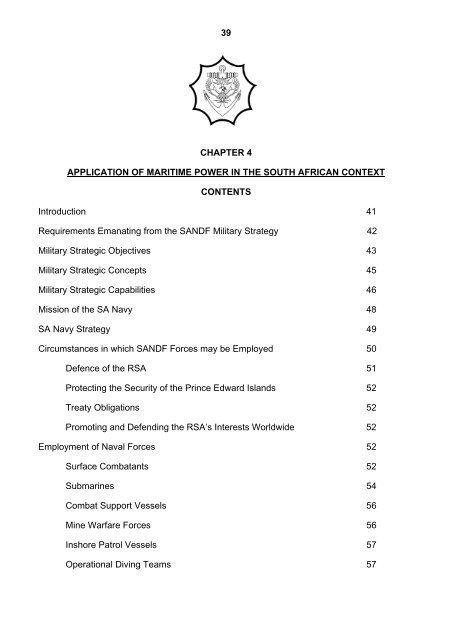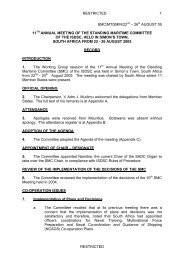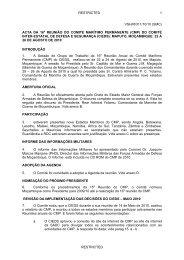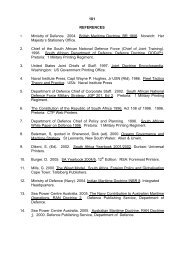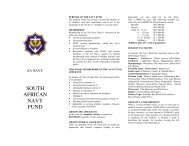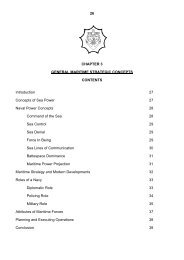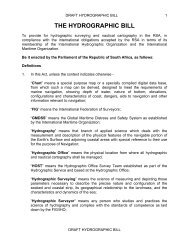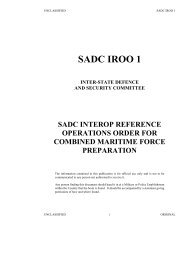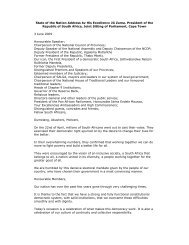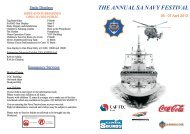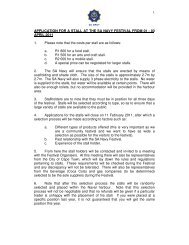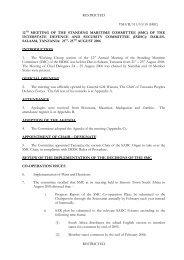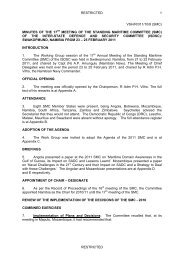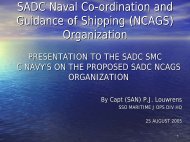Application of Maritime Power in - South African Navy
Application of Maritime Power in - South African Navy
Application of Maritime Power in - South African Navy
Create successful ePaper yourself
Turn your PDF publications into a flip-book with our unique Google optimized e-Paper software.
39<br />
CHAPTER 4<br />
APPLICATION OF MARITIME POWER IN THE SOUTH AFRICAN CONTEXT<br />
CONTENTS<br />
Introduction 41<br />
Requirements Emanat<strong>in</strong>g from the SANDF Military Strategy 42<br />
Military Strategic Objectives 43<br />
Military Strategic Concepts 45<br />
Military Strategic Capabilities 46<br />
Mission <strong>of</strong> the SA <strong>Navy</strong> 48<br />
SA <strong>Navy</strong> Strategy 49<br />
Circumstances <strong>in</strong> which SANDF Forces may be Employed 50<br />
Defence <strong>of</strong> the RSA 51<br />
Protect<strong>in</strong>g the Security <strong>of</strong> the Pr<strong>in</strong>ce Edward Islands 52<br />
Treaty Obligations 52<br />
Promot<strong>in</strong>g and Defend<strong>in</strong>g the RSA’s Interests Worldwide 52<br />
Employment <strong>of</strong> Naval Forces 52<br />
Surface Combatants 52<br />
Submar<strong>in</strong>es 54<br />
Combat Support Vessels 56<br />
M<strong>in</strong>e Warfare Forces 56<br />
Inshore Patrol Vessels 57<br />
Operational Div<strong>in</strong>g Teams 57
40<br />
<strong>Maritime</strong> Reaction Squadron 57<br />
Hydrographic Service 58<br />
<strong>Maritime</strong> Patrol Aircraft 58<br />
Naval Co-ord<strong>in</strong>ation and Guidance <strong>of</strong> Shipp<strong>in</strong>g 58<br />
Deployment <strong>of</strong> Forces 59<br />
Pr<strong>in</strong>ciples <strong>of</strong> War 59<br />
<strong>Application</strong> <strong>of</strong> Capabilities 65<br />
Conclusion 69
41<br />
CHAPTER 4<br />
APPLICATION OF MARITIME POWER IN THE SOUTH AFRICAN CONTEXT<br />
INTRODUCTION<br />
The previous two chapters describe the raison d’etre <strong>of</strong> the SA <strong>Navy</strong>, derived from higher<br />
order strategies and documents, and the traditional roles <strong>in</strong> which naval forces are deployed.<br />
This chapter will describe how the SA <strong>Navy</strong>’s assets are employed, consider<strong>in</strong>g the above<br />
factors.<br />
The primary objective <strong>of</strong> the SA National Defence Force is to protect the Republic, its<br />
territorial <strong>in</strong>tegrity and its people. In so do<strong>in</strong>g, it portrays the image <strong>of</strong> the “People’s <strong>Navy</strong>”.<br />
As no conventional military maritime threat aga<strong>in</strong>st the RSA currently exists, most <strong>of</strong> the<br />
tasks that the SA <strong>Navy</strong> conducts are with<strong>in</strong> the Diplomatic and Polic<strong>in</strong>g Roles. However, it<br />
must ma<strong>in</strong>ta<strong>in</strong> its conventional capabilities due to the volatility and uncerta<strong>in</strong>ty <strong>in</strong> the<br />
chang<strong>in</strong>g world.<br />
The traditional roles <strong>of</strong> a navy, as described <strong>in</strong> Chapter 3, can be directly l<strong>in</strong>ked to the<br />
approved three military strategic objectives <strong>of</strong> the SANDF, namely to<br />
a. enhance and ma<strong>in</strong>ta<strong>in</strong> comprehensive defence capabilities (Military Role);<br />
b. promote peace, security and stability <strong>in</strong> the region and on the cont<strong>in</strong>ent<br />
(Diplomatic and Polic<strong>in</strong>g Roles); and<br />
c. support to the people <strong>of</strong> <strong>South</strong> Africa (Diplomatic and Polic<strong>in</strong>g Roles).<br />
Although many <strong>of</strong> the roles are not <strong>of</strong> a military nature, the ships and submar<strong>in</strong>es still require<br />
to be prepared for tasks with<strong>in</strong> the Military Role and to combat unconventional threats as part<br />
<strong>of</strong> the <strong>in</strong>herent collateral value <strong>of</strong> navies. The unconventional threats that do exist are<br />
asymmetric <strong>in</strong> nature and tend towards acts <strong>of</strong> crim<strong>in</strong>ality and maritime terrorism, for<br />
example piracy, smuggl<strong>in</strong>g and the poach<strong>in</strong>g <strong>of</strong> resources.<br />
The SA <strong>Navy</strong> is a versatile medium regional, force projection navy with a limited blue water<br />
capability. The blue water capability is provided by the Frigates and submar<strong>in</strong>es, and is<br />
limited, because <strong>of</strong> the lack <strong>of</strong> resources to susta<strong>in</strong> operations and the lack <strong>of</strong> a sufficient<br />
number <strong>of</strong> platforms to operate simultaneously and <strong>in</strong>dependently, <strong>in</strong> different geographical<br />
areas for extended periods. The surveillance capability <strong>of</strong> the SA <strong>Navy</strong> is supported by the<br />
maritime patrol aircraft <strong>of</strong> the SA Air Force. Although they have a limited capability they are<br />
important <strong>in</strong> provid<strong>in</strong>g a maritime surveillance capability to the SANDF.<br />
The different types <strong>of</strong> force structure elements (FSEs) <strong>in</strong> the SA <strong>Navy</strong>’s <strong>in</strong>ventory, as<br />
described later <strong>in</strong> this chapter, underscore its versatility.
REQUIREMENTS EMANATING FROM THE SANDF MILITARY STRATEGY<br />
42<br />
The mandate <strong>of</strong> the SA <strong>Navy</strong> is drawn from the 1998 Defence Review, as amended <strong>in</strong> 2006,<br />
and the Defence Act 2002, Act No 42 <strong>of</strong> 2002, Article 12(1). This mandate requires the<br />
provision <strong>of</strong> naval forces, as the elements <strong>of</strong> the SANDF’s maritime capabilities, to<br />
a. counter attack from seaward and on shipp<strong>in</strong>g;<br />
b. provide for <strong>in</strong>terdiction with<strong>in</strong> the maritime battlespace once hostilities have<br />
begun;<br />
c. provide for counter-<strong>of</strong>fensive actions to drive the enemy from own or friendly<br />
sea-space;<br />
d. ensure that naval units have the <strong>in</strong>herent ability to function at the required jo<strong>in</strong>t<br />
levels, with<strong>in</strong> the SANDF command and control system;<br />
e. cont<strong>in</strong>uously prepare such naval forces for the defence <strong>of</strong> the RSA;<br />
f. prepare specified naval units to participate <strong>in</strong> operations other than war; and<br />
g. ma<strong>in</strong>ta<strong>in</strong> effective support capabilities to support all naval forces.<br />
Follow<strong>in</strong>g from the mandate, and always subject to the Constitution <strong>of</strong> the RSA and the laws<br />
govern<strong>in</strong>g the defence <strong>of</strong> <strong>South</strong> Africa, the vision <strong>of</strong> the SA <strong>Navy</strong> is to be unchallenged at<br />
sea. This implies the follow<strong>in</strong>g:<br />
a. Regional<br />
Reach. The<br />
SA <strong>Navy</strong><br />
provides<br />
susta<strong>in</strong>ed<br />
forces capable<br />
<strong>of</strong> operat<strong>in</strong>g<br />
throughout the<br />
<strong>South</strong>ern<br />
Oceans and<br />
<strong>South</strong>ern<br />
<strong>African</strong> littoral.<br />
b. Balance <strong>of</strong><br />
Force<br />
Capabilities.<br />
The size and<br />
shape <strong>of</strong> the<br />
SA <strong>Navy</strong> result<br />
<strong>in</strong> a coherent<br />
military<br />
The Frigates provide the SA <strong>Navy</strong> with regional reach and<br />
many <strong>of</strong> the capabilities that a Fleet requires to be a<br />
balanced force
43<br />
capability across all relevant areas <strong>of</strong> maritime warfare, together with the ability<br />
to operate these balanced forces effectively, giv<strong>in</strong>g it a battle w<strong>in</strong>n<strong>in</strong>g combat<br />
capability.<br />
c. Interoperability. The SA <strong>Navy</strong> is prepared for operations, jo<strong>in</strong>tly or <strong>in</strong><br />
comb<strong>in</strong>ation, with whatever other forces may be required, whether these be SA<br />
Armed Forces, the Armed Forces <strong>of</strong> the UN / AU / SADC / other nations or<br />
civilian authorities.<br />
d. Information Superiority. The SA <strong>Navy</strong> is capable <strong>of</strong> us<strong>in</strong>g <strong>in</strong>formation to<br />
achieve mission success by <strong>in</strong>creased situational awareness, <strong>in</strong>teroperability<br />
and <strong>in</strong>creased speed <strong>of</strong> <strong>in</strong>formation flow, whilst protect<strong>in</strong>g and preserv<strong>in</strong>g own<br />
<strong>in</strong>formation assets.<br />
e. Quality. The SA <strong>Navy</strong> provides capable forces that are completely fit for<br />
purpose as and when required.<br />
f. Will. The <strong>in</strong>dividuals, units and the command cha<strong>in</strong> <strong>of</strong> the SA <strong>Navy</strong> are will<strong>in</strong>g<br />
to become completely engaged <strong>in</strong> whatever task, from low <strong>in</strong>tensity peacetime<br />
activities to high <strong>in</strong>tensity war fight<strong>in</strong>g, with utter determ<strong>in</strong>ation to succeed.<br />
MILITARY STRATEGIC OBJECTIVES<br />
The military strategy is derived from the Constitution <strong>of</strong> the RSA, the Defence Act, the White<br />
Paper on Defence, the Defence Review and the National Security Strategy <strong>of</strong> the RSA. The<br />
need to actively promote peace and security <strong>in</strong> the region is a key tenet <strong>of</strong> the National<br />
Security Strategy, which directs the defence strategy.<br />
The military strategic objectives are the ends to be achieved by the SANDF. Each objective<br />
has a desired end state to be achieved. Once the end state is reached the objective has<br />
been satisfied. The objectives are not prioritised and cover the full range <strong>of</strong> military and<br />
other ordered commitments. The objectives are as follows:<br />
a. To Enhance and<br />
Ma<strong>in</strong>ta<strong>in</strong> Comprehensive<br />
Defence Capabilities.<br />
The provision <strong>of</strong> selfdefence<br />
<strong>in</strong> accordance<br />
with the <strong>in</strong>ternational law<br />
aga<strong>in</strong>st any external threat<br />
<strong>of</strong> aggression, which<br />
endangers the stability <strong>of</strong><br />
the RSA. The desired end<br />
state is a free <strong>South</strong> Africa<br />
that is not threatened by<br />
an external force, be it a<br />
nation, or a non-nation.<br />
Exercises are held to ensure the combat capability <strong>of</strong><br />
the weapons <strong>in</strong> order for the SA <strong>Navy</strong> to ma<strong>in</strong>ta<strong>in</strong> its<br />
comprehensive defence capability
44<br />
b. To Promote Peace, Security and Stability <strong>in</strong> the Region and the Cont<strong>in</strong>ent.<br />
The provision <strong>of</strong> external deployment or support to enhance security <strong>in</strong> support<br />
<strong>of</strong> decisions by the executive. The desired end state is a stable and prosperous<br />
<strong>African</strong> cont<strong>in</strong>ent. The tasks to achieve the objective <strong>in</strong>volve participat<strong>in</strong>g <strong>in</strong> and<br />
contribut<strong>in</strong>g to AU and Peace and Security structures, assist and participate <strong>in</strong><br />
post–conflict reconstruction activities <strong>in</strong> strife-torn and disaster hit countries <strong>in</strong><br />
Africa.<br />
The SA <strong>Navy</strong> donat<strong>in</strong>g harbour patrol boats to the Namibian<br />
<strong>Navy</strong> to assist them <strong>in</strong> secur<strong>in</strong>g their harbours and approaches<br />
c. To Support the People <strong>of</strong> <strong>South</strong> Africa. Support<strong>in</strong>g the population <strong>of</strong> the RSA<br />
<strong>in</strong> operations and activities other than war, when the responsible state<br />
departments do not have adequate capacity to do so. The desired end state is<br />
a <strong>South</strong> Africa with a developed <strong>in</strong>frastructure and educated citizens. The tasks<br />
<strong>in</strong>volved to satisfy the objective are to support the Government activities and<br />
<strong>in</strong>itiatives, eg national (Youth Day, Women’s Day, etc) and major events<br />
(elections); participat<strong>in</strong>g <strong>in</strong> disaster management and assist<strong>in</strong>g communities <strong>in</strong><br />
social development <strong>in</strong>itiatives.<br />
The SANDF missions identified to achieve the objectives for the next ten years are set out<br />
below. They are subject to constant review.
Enhance and Ma<strong>in</strong>ta<strong>in</strong><br />
Comprehensive Defence<br />
Capabilities<br />
• Repell<strong>in</strong>g <strong>of</strong> a<br />
conventional onslaught<br />
• Repell<strong>in</strong>g <strong>of</strong> an<br />
unconventional onslaught<br />
• Repell<strong>in</strong>g <strong>of</strong> a nonconventional<br />
onslaught<br />
• Defence aga<strong>in</strong>st a<br />
biological and/or<br />
chemical onslaught<br />
• Special operations<br />
• Pre-emptive<br />
operations<br />
• Protection <strong>of</strong><br />
foreign assets<br />
• Show <strong>of</strong> force<br />
• Defence<br />
aga<strong>in</strong>st an<br />
<strong>in</strong>formation<br />
onslaught<br />
45<br />
• VIP Air<br />
Transport for<br />
diplomatic<br />
commitments<br />
• Search and<br />
Rescue<br />
• Ma<strong>in</strong>tenance<br />
<strong>of</strong> health status<br />
<strong>of</strong> SANDF<br />
members<br />
• Presidential<br />
health support<br />
• Borderl<strong>in</strong>e Control<br />
• <strong>Maritime</strong> Support<br />
• Support to SAPS<br />
• Support to other<br />
Government<br />
Departments<br />
• Presidential tasks<br />
Support the People<br />
<strong>of</strong> <strong>South</strong> Africa<br />
Promote Peace, Security and<br />
Stability <strong>in</strong> the Region and on<br />
the Cont<strong>in</strong>ent<br />
• Support military<br />
foreign relations<br />
• International,<br />
Regional or Subregional<br />
peace<br />
missions:<br />
� Humanitarian<br />
<strong>in</strong>terventions<br />
� Observers<br />
� Peace-keep<strong>in</strong>g<br />
� Peace-mak<strong>in</strong>g<br />
� Peace-build<strong>in</strong>g<br />
� Peaceenforcement<br />
• Disaster-relief<br />
and humanitarian<br />
assistance<br />
Figure 4: Military Strategic Objectives
MILITARY STRATEGIC CONCEPTS<br />
46<br />
The military strategic concepts describe the ways to be followed to meet the military strategic<br />
objectives. The SANDF will use a mission-based approach to achieve the military strategic<br />
objectives <strong>of</strong> the DOD. This approach uses wartime and peacetime missions to direct the<br />
peacetime strategy for force preparation and to guide jo<strong>in</strong>t and comb<strong>in</strong>ed force preparation<br />
and force employment for <strong>in</strong>cidences <strong>of</strong> conflict. The concepts are as follows:<br />
a. Mission-Essential Tra<strong>in</strong><strong>in</strong>g. The SANDF is to educate, tra<strong>in</strong> and develop its<br />
personnel <strong>in</strong> the essential knowledge and skills required to execute the tasks<br />
necessary to accomplish its missions.<br />
Tra<strong>in</strong><strong>in</strong>g is provided to ensure that essential skills are<br />
ma<strong>in</strong>ta<strong>in</strong>ed<br />
b. Mission-Tra<strong>in</strong>ed Force. A force prepared and supported to execute identified<br />
missions (with<strong>in</strong> the parameters <strong>of</strong> the selective engagement concept).<br />
c. Selective Engagement. The concept <strong>of</strong> selective engagement <strong>in</strong>dicates that<br />
the SANDF will execute all the prescribed missions, but will be selective <strong>in</strong><br />
terms <strong>of</strong> the extent to which operations and tasks, emanat<strong>in</strong>g from these<br />
missions, will be executed. This concept implies that calculated risks will have<br />
to be taken. The C SANDF will advise the National Executive (the President<br />
and Cab<strong>in</strong>et) on the selection <strong>of</strong> the objective, who ultimately decides on the<br />
extent <strong>of</strong> the operations.<br />
d. Strategic Position<strong>in</strong>g. The SANDF will proactively establish a sound security<br />
environment, supported by <strong>in</strong>fluenc<strong>in</strong>g political and military foreign-relations<br />
actions, and the pre-placement <strong>of</strong> appropriate military capabilities.
MILITARY STRATEGIC CAPABILITIES<br />
47<br />
The capabilities <strong>of</strong> the SANDF constitute the means <strong>of</strong> the military strategy. The capabilities<br />
consist <strong>of</strong> the follow<strong>in</strong>g strategic capabilities:<br />
a. C 4 I 3 SR (Command and Control, Communications, Computers, Information,<br />
Intelligence, Infrastructure, Surveillance and Reconnaissance) Capability.<br />
In the maritime context, it means that good Command and Control channels are<br />
necessary for the forces to operate effectively. In order for the personnel to<br />
receive mission-essential tra<strong>in</strong><strong>in</strong>g to constitute a mission-tra<strong>in</strong>ed force, good<br />
<strong>in</strong>formation and <strong>in</strong>telligence is to be provided to the force prior and dur<strong>in</strong>g an<br />
operation.<br />
b. Light Mobile Capability. The <strong>in</strong>herent capability <strong>of</strong> ships is to be flexible and<br />
mobile <strong>in</strong> their deployment, as described <strong>in</strong> the previous chapter, satisfies this<br />
military strategic concept.<br />
c. Conventional Warfare Capability. The SA Naval forces will ma<strong>in</strong>ta<strong>in</strong> their<br />
conventional surface, submar<strong>in</strong>e and m<strong>in</strong>e warfare capabilities, plus receive<br />
combat support dur<strong>in</strong>g deployments. Those capabilities will be used for<br />
collateral tasks that arise from Operations other than War.<br />
d. Support Capability. The SA <strong>Navy</strong>’s technical and logistic support capability<br />
ensures that its ships rema<strong>in</strong> supported <strong>in</strong> preparation for and dur<strong>in</strong>g operations.<br />
The relationship between the military strategic objectives (ends), the missions that flow from<br />
the objectives and the concepts (ways) the SANDF uses to deploy its capabilities (means),<br />
are depicted <strong>in</strong> the follow<strong>in</strong>g diagram.
48<br />
MILITARY STRATEGY IN CONTEXT<br />
Expectations<br />
Domestic<br />
- Population<br />
- Parliament<br />
Foreign<br />
National Security Strategy<br />
Environmental changes<br />
MILITARY<br />
STRATEGIC<br />
CONCEPTS<br />
Mission -<br />
tra<strong>in</strong>ed<br />
Force<br />
Mission - based Approach<br />
Selective<br />
Engagement<br />
(Ways)<br />
Mission -<br />
essential<br />
Tra<strong>in</strong><strong>in</strong>g<br />
Strategic<br />
Position<strong>in</strong>g<br />
Legislative<br />
Imperative<br />
MISSION OF THE SA NAVY<br />
MILITARY<br />
STRATEGIC<br />
CAPABILITIES<br />
Missions<br />
Light Mobile<br />
C 4 I 3 RS<br />
To Enhance and<br />
Ma<strong>in</strong>ta<strong>in</strong> Comprehensive<br />
Defence Capabilities<br />
To Promote Peace, Security and<br />
Stability <strong>in</strong> the Region and <strong>in</strong> the<br />
Cont<strong>in</strong>ent<br />
To Support the People <strong>of</strong><br />
<strong>South</strong> Africa<br />
(Ends)<br />
Conventional<br />
Warfare<br />
Figure 5: Military Strategy <strong>in</strong> Context<br />
Strategic<br />
Support<br />
Capabilities<br />
MILITARY<br />
STRATEGIC<br />
OBJECTIVES<br />
Multi - role<br />
Preparation<br />
Reserves<br />
Skill - based<br />
Capability<br />
(Means)<br />
The Mission <strong>of</strong> the SA <strong>Navy</strong> is to provide combat ready and supported maritime defence<br />
capabilities for the defence and protection <strong>of</strong> the RSA. The Chief <strong>of</strong> the SA <strong>Navy</strong> is<br />
responsible to provide these forces to the Chief <strong>of</strong> Jo<strong>in</strong>t Operations who will employ them on<br />
behalf <strong>of</strong> the Chief <strong>of</strong> the SA National Defence Force. In order to achieve this Mission, the<br />
SA <strong>Navy</strong> shall focus its efforts on w<strong>in</strong>n<strong>in</strong>g at sea. This entails the follow<strong>in</strong>g:<br />
a. The SA <strong>Navy</strong> w<strong>in</strong>s at sea through the provision <strong>of</strong> combat ready and supported<br />
maritime defence capabilities for the defence and protection <strong>of</strong> the RSA.<br />
Operationalis<strong>in</strong>g the mission entails provid<strong>in</strong>g strategic direction for maritime<br />
defence, establish<strong>in</strong>g and ma<strong>in</strong>ta<strong>in</strong><strong>in</strong>g a force structure, tra<strong>in</strong><strong>in</strong>g personnel,<br />
ma<strong>in</strong>ta<strong>in</strong><strong>in</strong>g weapons systems and prepar<strong>in</strong>g forces.<br />
b. The SA <strong>Navy</strong> w<strong>in</strong>s at sea when its forces enable CJ Ops to succeed <strong>in</strong> fulfill<strong>in</strong>g<br />
its maritime-related strategic objectives <strong>of</strong> provid<strong>in</strong>g support to the people <strong>of</strong> the
49<br />
RSA, promot<strong>in</strong>g peace, security and stability <strong>in</strong> the region and cont<strong>in</strong>ent, and<br />
enhanc<strong>in</strong>g / ma<strong>in</strong>ta<strong>in</strong><strong>in</strong>g comprehensive defence capabilities.<br />
c. W<strong>in</strong>n<strong>in</strong>g at sea further implies that the SA <strong>Navy</strong> is capable <strong>of</strong> successfully<br />
achiev<strong>in</strong>g its vision through the establishment and support <strong>of</strong> technologically<br />
advanced and susta<strong>in</strong>ed maritime combat platforms and equipment, manned by<br />
highly competent and qualified personnel.<br />
d. The SA <strong>Navy</strong> can also w<strong>in</strong> at sea by be<strong>in</strong>g a credible deterrent force.<br />
Credibility is achieved by hav<strong>in</strong>g motivated and well-tra<strong>in</strong>ed personnel operat<strong>in</strong>g<br />
and us<strong>in</strong>g their equipment <strong>in</strong> the most efficient and pr<strong>of</strong>essional manner. Once<br />
the opponent is deterred from engag<strong>in</strong>g the SA Naval forces, the battle at sea is<br />
also won.<br />
SA NAVY STRATEGY<br />
The provision <strong>of</strong> maritime defence for the RSA is achieved through the development,<br />
management and ma<strong>in</strong>tenance <strong>of</strong> maritime capabilities that enable CJ Ops to implement the<br />
force employment strategy. The force employment strategy will be executed with a jo<strong>in</strong>t or<br />
mult<strong>in</strong>ational mission-tra<strong>in</strong>ed task force compris<strong>in</strong>g capabilities <strong>of</strong> all the Services and<br />
Divisions, either supported by or <strong>in</strong> support <strong>of</strong>, other role players.<br />
The force employment strategy also <strong>in</strong>dicates the strategic objectives for the short to medium<br />
term, and focuses on provid<strong>in</strong>g support to the people <strong>of</strong> the RSA, promot<strong>in</strong>g peace, security<br />
and stability <strong>in</strong> the region and the cont<strong>in</strong>ent, and enhanc<strong>in</strong>g / ma<strong>in</strong>ta<strong>in</strong><strong>in</strong>g comprehensive<br />
defence capabilities. This implies that the SA <strong>Navy</strong> must ensure the follow<strong>in</strong>g:<br />
a. Ma<strong>in</strong>tenance <strong>of</strong> a demonstrated, deterrent defence capability given the <strong>in</strong>herent<br />
unpredictability <strong>of</strong> the future and the time taken to build up a defence capability.<br />
The follow<strong>in</strong>g naval missions, derived from the SANDF missions, are envisaged<br />
for the next ten years:<br />
i. Operations aga<strong>in</strong>st enemy forces.<br />
ii. Protection <strong>of</strong> maritime trade (<strong>in</strong>clud<strong>in</strong>g naval co-ord<strong>in</strong>ation and guidance<br />
<strong>of</strong> shipp<strong>in</strong>g).<br />
iii. Combat operations aga<strong>in</strong>st oppos<strong>in</strong>g land forces.<br />
iv. Combat operations <strong>in</strong> support <strong>of</strong> and the defence <strong>of</strong> own land forces.<br />
v. Combat and non-combat evacuation operations.<br />
vi. Combat search and rescue.<br />
b. Promotion <strong>of</strong> peace, security and stability <strong>in</strong> the region and cont<strong>in</strong>ent by<br />
engag<strong>in</strong>g <strong>in</strong> co-operative ventures with its counterparts throughout the region <strong>in</strong><br />
such fields as maritime defence plann<strong>in</strong>g, comb<strong>in</strong>ed exercises, procurement <strong>of</strong><br />
arms and equipment, tra<strong>in</strong><strong>in</strong>g and education and the conduct <strong>of</strong> exchange<br />
visits. The follow<strong>in</strong>g naval missions, derived from the SANDF missions, are
50<br />
envisaged for the next ten years. These missions would be conducted outside<br />
the territorial waters <strong>of</strong> the RSA.<br />
i. Embargo, sanctions, blockade and quarant<strong>in</strong>e enforcement.<br />
ii. Peace Support Operations, which <strong>in</strong>cludes Peacekeep<strong>in</strong>g, Peace<br />
Enforcement and Peace Build<strong>in</strong>g Operations.<br />
iii. Anti-piracy and anti-sea robbery operations.<br />
iv. Fishery protection.<br />
v. Drug <strong>in</strong>terdiction.<br />
vi. Anti-contraband operations.<br />
vii. River<strong>in</strong>e and <strong>in</strong>land lake patrols.<br />
viii. <strong>Maritime</strong> counter terrorism.<br />
ix. Support to counter <strong>in</strong>surgency operations.<br />
x. Enforcement <strong>of</strong> maritime agreements.<br />
c. Provision <strong>of</strong> support to the people <strong>of</strong> the RSA by play<strong>in</strong>g an active role with<strong>in</strong><br />
the <strong>in</strong>ternal maritime sector <strong>in</strong> order to ensure optimum utilisation <strong>of</strong> all State<br />
maritime resources. Most <strong>of</strong> the missions will be undertaken <strong>in</strong> support to other<br />
government departments where they are the lead<strong>in</strong>g department. The<br />
follow<strong>in</strong>g naval missions, derived from the SANDF missions, are envisaged for<br />
the next ten years:<br />
i. Humanitarian aid and disaster relief.<br />
ii. Border safeguard<strong>in</strong>g.<br />
iii. Search and rescue.<br />
iv. Hydrographic survey<strong>in</strong>g.<br />
v. Support to other Government Departments.<br />
CIRCUMSTANCES IN WHICH MARITIME FORCES MAY BE EMPLOYED<br />
The SANDF Defence Doctr<strong>in</strong>e <strong>in</strong>dicates the circumstances <strong>in</strong> which SANDF forces may be<br />
employed. These circumstances are <strong>in</strong>dicated below and will be used as background for<br />
further discussion on the maritime missions that the SA <strong>Navy</strong> must be capable <strong>of</strong> execut<strong>in</strong>g.<br />
Protect<strong>in</strong>g the security <strong>of</strong> the RSA <strong>in</strong>cludes the capacity to deter and spans the range from<br />
national operations such as support<strong>in</strong>g the civil authorities up to and <strong>in</strong>clud<strong>in</strong>g limited war.<br />
Support<strong>in</strong>g the civil authorities could <strong>in</strong>volve a range <strong>of</strong> defence capabilities depend<strong>in</strong>g on
51<br />
the nature <strong>of</strong> the operation. These might range from provid<strong>in</strong>g limited staff to support any<br />
government department for the socio-economic upliftment <strong>of</strong> the community, or assist<strong>in</strong>g<br />
local authorities dur<strong>in</strong>g natural disasters, to the use <strong>of</strong> significant resources such as those<br />
that may be required to assist the civil power <strong>in</strong> counter<strong>in</strong>g terrorism. Involvement <strong>in</strong> UN<br />
Peacekeep<strong>in</strong>g Operations is also possible. A limited war, which could be fought alongside<br />
SADC, AU or UN-sanctioned forces, would require the full range <strong>of</strong> war fight<strong>in</strong>g capabilities<br />
and larger forces than might be needed <strong>in</strong> other circumstances. Although limited war is<br />
judged to be an unlikely cont<strong>in</strong>gency <strong>in</strong> present circumstances, the Government's ultimate<br />
responsibility for national survival means that its armed forces must be capable <strong>of</strong> deterr<strong>in</strong>g<br />
or, after due warn<strong>in</strong>g and mobilisation, <strong>of</strong> fight<strong>in</strong>g a limited war. In summary, as provided for<br />
<strong>in</strong> the Constitution <strong>of</strong> the RSA, the SANDF (and therefore the SA <strong>Navy</strong>) may be employed <strong>in</strong><br />
the follow<strong>in</strong>g functions for service <strong>in</strong><br />
a. defence <strong>of</strong> the RSA, for protection <strong>of</strong> its sovereignty and territorial <strong>in</strong>tegrity;<br />
b. compliance with the <strong>in</strong>ternational obligations <strong>of</strong> the RSA with regard to<br />
<strong>in</strong>ternational bodies and other states;<br />
c. the preservation <strong>of</strong> life, health and property;<br />
d. the provision or ma<strong>in</strong>tenance <strong>of</strong> essential services;<br />
e. the uphold<strong>in</strong>g <strong>of</strong> law and order <strong>in</strong> the RSA <strong>in</strong> co-operation with the SA Police<br />
Service under circumstances set out <strong>in</strong> law where the Police Service is unable<br />
to ma<strong>in</strong>ta<strong>in</strong> law and order on its own; and<br />
f. support <strong>of</strong> any department <strong>of</strong> state for the purpose <strong>of</strong> social upliftment.<br />
It is the policy <strong>of</strong> the State that the primary function <strong>of</strong> the SANDF will be to defend the RSA<br />
aga<strong>in</strong>st external aggression, with the other functions be<strong>in</strong>g secondary.<br />
Defence <strong>of</strong> the RSA. The <strong>Maritime</strong> Doctr<strong>in</strong>e underscores the Defence Policy to ensure a<br />
secure <strong>South</strong> Africa. Defence Policy sets the objectives <strong>of</strong> the Military Strategy, shapes the<br />
structure and capabilities <strong>of</strong> the armed forces and guides the contribution they make to the<br />
security <strong>of</strong> the country, <strong>in</strong> terms <strong>of</strong> the protection and promotion <strong>of</strong> national <strong>in</strong>terests. This is<br />
done as follows:<br />
a. Protection. An effective maritime capability is necessary to deter or defend<br />
the country aga<strong>in</strong>st an aggressor who threatens the territory or <strong>in</strong>terests <strong>of</strong> the<br />
RSA. The country must reta<strong>in</strong> the capability for <strong>in</strong>dependent action to meet the<br />
national obligations at home and abroad. As many <strong>of</strong> the RSA’s national<br />
<strong>in</strong>terests are shared with other countries from <strong>South</strong>ern Africa and further a<br />
field, national security can best be guaranteed through defence <strong>in</strong> co-operation<br />
with allies or coalition partners. This may be achieved through, among other<br />
organs, the Stand<strong>in</strong>g <strong>Maritime</strong> Committee (SMC) <strong>of</strong> the Inter-State Defence<br />
and Security Committee (ISDSC). SA <strong>Navy</strong> resources can be used <strong>in</strong><br />
conjunction with the resources <strong>of</strong> the neighbour<strong>in</strong>g countries. This <strong>in</strong>cludes the<br />
exchange <strong>of</strong> personnel between the vessels.
52<br />
b. Promotion <strong>of</strong> National Interests. A credible maritime capability is important<br />
for the promotion <strong>of</strong> the wider <strong>in</strong>terests, to confer <strong>in</strong>fluence and to underp<strong>in</strong><br />
diplomacy.<br />
Protect<strong>in</strong>g the Security <strong>of</strong> the Pr<strong>in</strong>ce Edward Islands. As part <strong>of</strong> its function <strong>of</strong> protect<strong>in</strong>g<br />
the sovereignty <strong>of</strong> the RSA and its territorial <strong>in</strong>tegrity, the SA <strong>Navy</strong> will be required to protect<br />
the territorial <strong>in</strong>tegrity <strong>of</strong> the Pr<strong>in</strong>ce Edward Island group and its surround<strong>in</strong>g Exclusive<br />
Economic Zone (EEZ). For the foreseeable future, any such operation would probably be<br />
limited to prevent<strong>in</strong>g exploitation <strong>of</strong> the natural resources <strong>in</strong> the EEZ and future extended<br />
cont<strong>in</strong>ental shelf.<br />
Treaty Obligations. Membership <strong>of</strong> the SADC, the AU and the UN place obligations on the<br />
RSA Government to deploy forces to help assist members states <strong>in</strong> ensur<strong>in</strong>g stability <strong>in</strong> their<br />
respective countries and the region. This will happen even if the security <strong>of</strong> the RSA is not<br />
directly threatened.<br />
Promot<strong>in</strong>g and Defend<strong>in</strong>g the RSA's Interests Worldwide. SA <strong>Navy</strong> forces may be used<br />
to promote the RSA's <strong>in</strong>terests <strong>in</strong> a wide variety <strong>of</strong> ways, <strong>in</strong>clud<strong>in</strong>g support to diplomacy,<br />
military assistance and humanitarian and peace missions. Circumstances may require the<br />
defence <strong>of</strong> the RSA's <strong>in</strong>terests. Depend<strong>in</strong>g on the nature <strong>of</strong> the <strong>in</strong>terest <strong>in</strong>volved and the<br />
seriousness <strong>of</strong> the threat, the Government is likely to have a greater prerogative regard<strong>in</strong>g<br />
the nature and size <strong>of</strong> the forces it commits to such an operation than it would if the RSA's<br />
territorial <strong>in</strong>tegrity were under attack. In view <strong>of</strong> the RSA's <strong>in</strong>terests and dependence on<br />
regional trade with SADC countries, it is likely that any serious threats to the security <strong>of</strong><br />
SADC member states would also represent a threat to the RSA's <strong>in</strong>terests. In these<br />
circumstances, SA <strong>Navy</strong> forces may take part <strong>in</strong> operations authorised by the UN and/or the<br />
AU/SADC to defend or restore peace and security <strong>in</strong> the SADC region. This is likely to be<br />
with<strong>in</strong> the context <strong>of</strong> an alliance or coalition.<br />
EMPLOYMENT OF SA NAVY FORCES<br />
Hav<strong>in</strong>g reviewed the circumstances and missions under which the SA <strong>Navy</strong> forces are to be<br />
employed, the follow<strong>in</strong>g section will discuss the range and capabilities <strong>of</strong> selected FSEs.<br />
SURFACE COMBATANTS<br />
The Frigates provide the surface combat capability <strong>of</strong> the SA <strong>Navy</strong>. They are therefore, the<br />
prime means <strong>of</strong> protect<strong>in</strong>g own and allied shipp<strong>in</strong>g and the movement <strong>of</strong> sea-borne trade <strong>in</strong><br />
our sea l<strong>in</strong>es <strong>of</strong> communication (SLOCs) from hostile forces. It is an <strong>in</strong>termediate size vessel<br />
with good sea-keep<strong>in</strong>g characteristics that enables susta<strong>in</strong>ed operational presence <strong>of</strong> the SA<br />
<strong>Navy</strong> <strong>in</strong> the littoral waters.<br />
The Frigate is a multi-purpose vessel capable <strong>of</strong> operat<strong>in</strong>g <strong>in</strong>dividually, or jo<strong>in</strong>tly as a<br />
member <strong>of</strong> a task force with other surface combatants to counter air, surface and subsurface<br />
threats/forces. Its combat roles <strong>in</strong>clude<br />
a. <strong>in</strong>terdiction aga<strong>in</strong>st hostile air, surface and sub-surface threats <strong>in</strong> the deep<br />
battle space areas;<br />
b. support <strong>of</strong> land forces <strong>in</strong> the deep battle space areas;
53<br />
c. provision <strong>of</strong> a jo<strong>in</strong>t operations command, control, communications, <strong>in</strong>telligence<br />
and <strong>in</strong>formation (C 3 I 2 ) warfare platform;<br />
d. escort duties and area protection <strong>of</strong> own SLOCs <strong>in</strong> the close and rear<br />
battlespace areas;<br />
Due to its size and sea-keep<strong>in</strong>g ability, a Frigate is capable <strong>of</strong> operat<strong>in</strong>g specialised maritime<br />
helicopters <strong>in</strong> marg<strong>in</strong>al sea conditions, as are experienced with<strong>in</strong> the <strong>South</strong> <strong>African</strong> Exclusive<br />
Economic Zone (EEZ). These helicopters form an <strong>in</strong>tegral part <strong>of</strong> the Frigates’ combat ability<br />
- they are capable <strong>of</strong> deploy<strong>in</strong>g forward sensors and weapons ahead <strong>of</strong> the task group <strong>in</strong><br />
order to sanitise the future battlespace.<br />
Other<br />
than combat missions, the multi-dimensional nature <strong>of</strong> a Frigate enables it to cover a<br />
wide range <strong>of</strong> collateral tasks <strong>in</strong> support <strong>of</strong> the RSA Government and national strategies.<br />
These tasks <strong>in</strong>clude the follow<strong>in</strong>g:<br />
a. Peace Support Operations (PSOs) <strong>in</strong> Africa.<br />
b.<br />
Evacuation <strong>of</strong> civilian nationals from littoral states <strong>in</strong> times <strong>of</strong> crisis.<br />
c.<br />
Patroll<strong>in</strong>g for<br />
The commission<strong>in</strong>g <strong>of</strong> the 4 th Frigate SAS MENDI <strong>in</strong> the shipyard<br />
<strong>of</strong> HDW<br />
i. the protection <strong>of</strong> mar<strong>in</strong>e resources aga<strong>in</strong>st poach<strong>in</strong>g and pollution; and<br />
ii.<br />
law enforcement (the prevention <strong>of</strong> piracy, smuggl<strong>in</strong>g <strong>of</strong> illegal weapons,<br />
substances and contraband) <strong>of</strong> own and fellow <strong>South</strong>ern <strong>African</strong><br />
Development Community (SADC) states territorial waters and EEZs<br />
from foreign exploitation.
54<br />
d. Search<br />
and Rescue (SAR) missions with<strong>in</strong> our <strong>in</strong>ternational SAR area <strong>of</strong><br />
responsibility (which extends as far south as the Pr<strong>in</strong>ce Edward Group <strong>of</strong><br />
Islands).<br />
The Constitution <strong>of</strong> the RSA, the White Paper on Defence and the Defence Review are<br />
explicit <strong>in</strong> specify<strong>in</strong>g the primarily defensive posture <strong>of</strong> the SANDF. A Frigate provides a<br />
multi-dimensional platform capable <strong>of</strong> execut<strong>in</strong>g either peacetime roles, or respond<strong>in</strong>g to the<br />
hostilities <strong>of</strong> a belligerent. The presence <strong>of</strong> a surface combatant <strong>of</strong> the calibre <strong>of</strong> a Frigate, is<br />
a manifestation <strong>of</strong> the determ<strong>in</strong>ation <strong>of</strong> the RSA Government to<br />
a. defend its territorial <strong>in</strong>tegrity and its people; and<br />
b.<br />
fulfil its role as a stabilis<strong>in</strong>g force <strong>in</strong> the <strong>African</strong> sub-cont<strong>in</strong>ent.<br />
Lynx helicopter with the Frigate <strong>in</strong> the background<br />
SUBMARINES<br />
The use <strong>of</strong> a maritime combat<br />
helicopter (MCH) greatly enhances<br />
the capability <strong>of</strong> a fight<strong>in</strong>g force. The<br />
MCH extends the visual horizon <strong>of</strong><br />
the surface vessel, as well as<br />
<strong>in</strong>creas<strong>in</strong>g the effective range <strong>of</strong> the<br />
ship’s sensors and weapons.<br />
Furthermore, MCHs may be<br />
equipped with a range <strong>of</strong> weapons<br />
<strong>in</strong>clud<strong>in</strong>g air-to-air missiles, air-tosurface<br />
missiles and lightweight<br />
torpedoes (LWTs). They are, <strong>in</strong><br />
addition, effective anti-submar<strong>in</strong>e<br />
warfare platforms when equipped<br />
with a dipp<strong>in</strong>g sonar and/or sonar<br />
buoys, LWTs and depth charges.<br />
Conventional submar<strong>in</strong>es play a major role <strong>in</strong> littoral maritime warfare. They are mobile,<br />
versatile and resilient. They can contribute reach to any campaign or operation. They are<br />
also suitable for reconnaissance and surveillance tasks.<br />
Due<br />
to the nature <strong>of</strong> the environment, the sea is largely opaque to a variety <strong>of</strong> sensors. It<br />
can, therefore, be used as a hid<strong>in</strong>g place for submar<strong>in</strong>es. Deep water enhances a<br />
submar<strong>in</strong>e’s capability <strong>of</strong> three-dimensional mobility, thus promot<strong>in</strong>g its ability to rema<strong>in</strong><br />
undetected <strong>in</strong> both attack and evasion. The discretion <strong>of</strong> a submar<strong>in</strong>e <strong>in</strong> the conf<strong>in</strong>es <strong>of</strong><br />
littoral waters is enhanced by poor sonar conditions and the proximity and pr<strong>of</strong>ile <strong>of</strong> the<br />
seabed to avoid detection.
55<br />
The SA <strong>Navy</strong> has an excellent submar<strong>in</strong>e capability <strong>in</strong> its Type 209’s. As it is<br />
the only sub-Saharan country operat<strong>in</strong>g submar<strong>in</strong>es <strong>in</strong> Africa, they can be<br />
used as a covert means <strong>of</strong> conduct<strong>in</strong>g maritime surveillance lent<br />
In areas where an overt above-water presence <strong>of</strong> naval forces and surveillance aircraft is<br />
neither advisable nor possible, submar<strong>in</strong>es are well suited to carry out a wide range <strong>of</strong><br />
surveillance, reconnaissance, situation analysis and verification missions. Because they<br />
operate “unseen”, a submar<strong>in</strong>e’s immediate use <strong>in</strong> an area can be covert and nonthreaten<strong>in</strong>g,<br />
and will not impact upon the diplomatic tensions <strong>of</strong> the area.<br />
In a conflict situation, the mission spectrum <strong>of</strong> a submar<strong>in</strong>e may <strong>in</strong>clude the<br />
a. protection <strong>of</strong> the maritime territorial <strong>in</strong>tegrity <strong>of</strong> the RSA;<br />
b. protection <strong>of</strong> the national and allied SLOCs; and<br />
c. disruption <strong>of</strong> a belligerent’s SLOCs.<br />
This will require a submar<strong>in</strong>e to carry out operations for the protection <strong>of</strong> our own (and<br />
possibly allied) merchant vessels and coastl<strong>in</strong>es <strong>in</strong> our rear areas, and the <strong>in</strong>terdiction <strong>of</strong><br />
hostile surface units, submar<strong>in</strong>es and merchant vessels <strong>in</strong> the close and deep battlespace<br />
areas. A submar<strong>in</strong>e’s ability to poise makes it a powerful tool <strong>in</strong> maritime operations, and its<br />
capacity for leverage, particularly wrt expeditionary and sea denial operations is <strong>of</strong> greater<br />
importance than ever <strong>in</strong> today’s world <strong>of</strong> risks, volatilities and uncerta<strong>in</strong>ties.<br />
As a result <strong>of</strong> their unique and characteristic features, only submar<strong>in</strong>es are able to ma<strong>in</strong>ta<strong>in</strong> a<br />
deterrence over a long time <strong>in</strong> an area dom<strong>in</strong>ated by superior opponent forces. Their<br />
presence is a manifestation <strong>of</strong> the determ<strong>in</strong>ation <strong>of</strong> the Government to defend the territorial<br />
<strong>in</strong>tegrity and the people <strong>of</strong> the RSA, and if so called upon, to react aga<strong>in</strong>st the hostilities <strong>of</strong> an<br />
opponent. Submar<strong>in</strong>es are a force <strong>in</strong> be<strong>in</strong>g, a force never to be discounted. And as they lurk
56<br />
undetected, they deter. Used wisely, they are the RSA’s ultimate strategic defence<br />
mechanism and can be used for early warn<strong>in</strong>g.<br />
COMBAT SUPPORT VESSELS<br />
The combat support vessels provide logistic support to the fleet. They are able to provide<br />
the capability for underway replenishment <strong>of</strong> fuel, water, stores and ammunition, and bulk<br />
fuel transport. Such a capability allows the SA <strong>Navy</strong> to conduct blue water and/or foreign<br />
deployments, as well as limited susta<strong>in</strong>ed operations with<strong>in</strong> a s<strong>in</strong>gle theatre <strong>of</strong> operations.<br />
Besides provid<strong>in</strong>g support to the SA <strong>Navy</strong>’s ships and submar<strong>in</strong>es dur<strong>in</strong>g conflict, the<br />
Combat Support Vessels are also <strong>in</strong>valuable <strong>in</strong> a wide range <strong>of</strong> military operations other than<br />
war. In this regard they can be used for the follow<strong>in</strong>g:<br />
a. The transportation <strong>of</strong> limited land forces and their equipment to any area from<br />
where the SANDF might be required to deploy for a mission where a sealift<br />
capability is required.<br />
b. The provision<strong>in</strong>g <strong>of</strong> both temporary accommodation for refugees as well as<br />
limited hospital/medical facilities.<br />
c. The transportation <strong>of</strong> material and equipment to areas where social<br />
disturbances or natural disasters have caused humanitarian distress.<br />
d. General tasks <strong>in</strong> support <strong>of</strong> other state departments.<br />
e. The provision<strong>in</strong>g <strong>of</strong> a platform for helicopter operations.<br />
MINE WARFARE FORCES<br />
The M<strong>in</strong>e Warfare Forces provide a capability that enables port approaches and harbour<br />
channels to be kept clear <strong>of</strong> any threat from m<strong>in</strong>es or unidentified submerged objects. They<br />
are used <strong>in</strong> the first step to ensure free access to the sea and the RSA’s SLOCs.<br />
Consider<strong>in</strong>g the importance <strong>of</strong> maritime trade to the prosperity <strong>of</strong> the RSA, access through<br />
the country’s ports is to be ensured at all times. They also provide the clearance to the<br />
approaches to beaches for land<strong>in</strong>g operations.<br />
The SA <strong>Navy</strong> is mov<strong>in</strong>g away from hav<strong>in</strong>g dedicated MCM vessels for M<strong>in</strong>e Warfare<br />
operations, to acquir<strong>in</strong>g a core capability, which can be expanded when the threat arises.<br />
The capability will consist <strong>of</strong> unmanned or remote controlled vehicles for m<strong>in</strong>e detection and<br />
neutralisation. This capability will be operated from vessels <strong>of</strong> opportunity, therefore,<br />
dedicated MCM vessels are not required.
INSHORE PATROL VESSELS<br />
57<br />
Inshore Patrol Vessels are lightly armed vessels with a limited deployment capability. They<br />
provide the patrol capability <strong>of</strong> the SA <strong>Navy</strong> and are mostly <strong>in</strong>volved <strong>in</strong> the polic<strong>in</strong>g role<br />
whereby they patrol the RSA’s <strong>in</strong>shore coastal waters and port approaches.<br />
The harbour and <strong>in</strong>shore patrol vessels exercis<strong>in</strong>g <strong>of</strong>f Durban harbour.<br />
These vessels form the <strong>in</strong>ner layer <strong>of</strong> defence aga<strong>in</strong>st smaller vessels and they also ensure<br />
sufficient <strong>in</strong>shore presence, <strong>in</strong> support <strong>of</strong> operations, such as the enforcement <strong>of</strong> state<br />
authority and the uphold<strong>in</strong>g and restoration <strong>of</strong> law and order. They can be deployed to other<br />
<strong>African</strong> countries to assist <strong>in</strong> patroll<strong>in</strong>g their <strong>in</strong>shore waters.<br />
OPERATIONAL DIVING TEAMS<br />
Operational Div<strong>in</strong>g Teams allow for operational div<strong>in</strong>g tasks such as m<strong>in</strong>e identification, m<strong>in</strong>e<br />
avoidance, m<strong>in</strong>e clearance, beachhead clearance, explosive ordnance disposal and they<br />
provide a SAR capability. These teams can be deployed to foreign countries to assist with<br />
their div<strong>in</strong>g requirements.<br />
MARITIME REACTION SQUADRON (MRS)<br />
The <strong>Maritime</strong> Reaction Squadron will undertake the follow<strong>in</strong>g tasks:<br />
a. Conduct <strong>in</strong>land water patrols, <strong>in</strong>clud<strong>in</strong>g lakes, waterways and river<strong>in</strong>e patrols.<br />
b. Conduct search and seizure operations dur<strong>in</strong>g <strong>in</strong>land water patrols.
c. Conduct board<strong>in</strong>g operations <strong>in</strong> national and <strong>in</strong>ternational waters.<br />
58<br />
d. Provide a deployable small craft, both <strong>in</strong>shore <strong>in</strong> the littoral and on <strong>in</strong>land waters<br />
<strong>in</strong> a defensive role.<br />
e. Protect SA <strong>Navy</strong> vessels <strong>in</strong> national and <strong>in</strong>ternational harbours and anchorages.<br />
f. Protect SA <strong>Navy</strong> vessels <strong>in</strong> harbours and anchorages other than local naval<br />
harbours.<br />
g. Conduct ship-to-shore (‘over-the-beach’) operations and shore-to-shore (‘overthe-beach’<br />
and/or secure harbour) operations.<br />
h. Transport limited numbers <strong>of</strong> personnel <strong>in</strong> the <strong>in</strong>shore littoral and the <strong>in</strong>land<br />
waters.<br />
i. Provide operational small craft support services to other state departments, for<br />
example to conduct non-combat evacuation operations (NEOs).<br />
j. Establish a Forward Deployed Base from which such operations may be<br />
conducted. In establish<strong>in</strong>g this capability, all the <strong>in</strong>tegrated logistic support<br />
elements will be taken <strong>in</strong>to consideration, for example communications<br />
<strong>in</strong>frastructure, technical and logistical support.<br />
HYDROGRAPHIC SERVICE<br />
The SAN fulfils its regional and <strong>in</strong>ternational obligations to provide a hydrographic service to<br />
the maritime community, through its survey vessel and the ashore hydrographic<br />
<strong>in</strong>frastructure.<br />
MARITIME PATROL AIRCRAFT<br />
<strong>Maritime</strong> Patrol Aircraft (MPAs) provide an effective method <strong>of</strong> patroll<strong>in</strong>g large areas and<br />
scout<strong>in</strong>g for friendly/enemy forces <strong>in</strong> a given time. Although the current aircraft have<br />
limitations wrt their ability to provide a cont<strong>in</strong>uous and effective maritime patrol and deterrent<br />
capability, the <strong>in</strong>formation they provide is used for <strong>in</strong>telligence purposes.<br />
The MPAs do not belong to the SA <strong>Navy</strong>, but are operated and controlled by the <strong>South</strong><br />
<strong>African</strong> Air Force (SAAF). The <strong>in</strong>formation ga<strong>in</strong>ed is, however, used by the SA <strong>Navy</strong>’s forces<br />
patroll<strong>in</strong>g the RSA’s territorial waters.<br />
NAVAL CO-ORDINATION AND GUIDANCE OF SHIPPING (NCAGS)<br />
The NCAGS organisation is used <strong>in</strong> times <strong>of</strong> conflict to route merchant shipp<strong>in</strong>g through<br />
areas <strong>of</strong> least danger to avoid enemy combatants.
DEPLOYMENT OF FORCES<br />
59<br />
In its quest for <strong>in</strong>ternational co-operation and <strong>in</strong>ternational exposure <strong>of</strong> its personnel to<br />
foreign countries, the SA <strong>Navy</strong> will participate <strong>in</strong> the stand<strong>in</strong>g <strong>in</strong>ternational commitments on a<br />
regular basis, as prescribed <strong>in</strong> Memoranda <strong>of</strong> Understand<strong>in</strong>g (MoUs) and Agreements.<br />
PRINCIPLES OF WAR<br />
In plann<strong>in</strong>g for war and <strong>in</strong> execut<strong>in</strong>g that<br />
plan, commanders and their staffs at all<br />
levels need to take certa<strong>in</strong> pr<strong>in</strong>ciples<br />
<strong>in</strong>to consideration. The <strong>in</strong>dividual<br />
pr<strong>in</strong>ciples described below are not rigid<br />
laws, but provide guidance on which<br />
military action will be based.<br />
Military personnel and writers, who<br />
derived them by analys<strong>in</strong>g history and<br />
contemporary warfare, developed the<br />
Pr<strong>in</strong>ciples <strong>of</strong> War. The Pr<strong>in</strong>ciples <strong>of</strong> War<br />
constitute a collection <strong>of</strong> common-sense<br />
ideas, and they must be understood <strong>in</strong><br />
their entirety, not as dogma to be rigidly<br />
applied.<br />
Their applicability and relative<br />
importance changes with the<br />
circumstances: the application <strong>of</strong><br />
judgement and common sense may<br />
lead to success, blatant disregard<br />
<strong>in</strong>volves risk and could lead to failure.<br />
This <strong>in</strong> itself is a sound reason why<br />
commanders must rema<strong>in</strong> flexible <strong>in</strong><br />
their th<strong>in</strong>k<strong>in</strong>g. The <strong>South</strong> <strong>African</strong><br />
The Orig<strong>in</strong> <strong>of</strong> the Pr<strong>in</strong>ciples <strong>of</strong> War<br />
Dur<strong>in</strong>g the late 18 th century there was an effort to place<br />
warfare on a scientific basis. The first effort to write a<br />
scientific document was seen as Vauban, who wrote a<br />
manual on field eng<strong>in</strong>eer<strong>in</strong>g. Lancelot de Turp<strong>in</strong> de<br />
Crisse, 18 th century French count and military leader,<br />
was the first writer to suggest that there could be<br />
pr<strong>in</strong>ciples <strong>of</strong> warfare.<br />
A. Gat. The Orig<strong>in</strong>s <strong>of</strong> Military Thought, from the<br />
Enlightenment to Clausewitz. Oxford: Clarendon.<br />
1989. pp. 36-37.<br />
The first to actually formulate pr<strong>in</strong>ciples <strong>of</strong> war was Henry<br />
Lloyd, a soldier <strong>of</strong> fortune, who wrote on achiev<strong>in</strong>g<br />
certa<strong>in</strong>ty <strong>in</strong> war by means <strong>of</strong> pr<strong>in</strong>ciples <strong>of</strong> war. His<br />
pr<strong>in</strong>ciples <strong>in</strong>cluded; Concentration: Only an undivided<br />
army … can hope to avoid defeat. Security: Keep<strong>in</strong>g the<br />
l<strong>in</strong>es <strong>of</strong> operation safe and short.<br />
B.D. Watts, Clausewitzian Friction and Future War,<br />
2 nd Edition, Chapter 3.<br />
Thereafter Clausewitz developed an extensive set <strong>of</strong><br />
pr<strong>in</strong>ciples to teach the Kaiser’s son. He later wrote <strong>in</strong> his<br />
book On War that pr<strong>in</strong>ciples <strong>of</strong> war should not be<br />
followed bl<strong>in</strong>dly. Others used Lloyd’s thoughts to expand<br />
on this idea <strong>of</strong> pr<strong>in</strong>ciples, such as Dietrich A.H. von<br />
Bülow, Anto<strong>in</strong>e-Henri Jom<strong>in</strong>i, G.F.R. Henderson,<br />
Ferd<strong>in</strong>and Foch, Arthur Bryant and J.F.C. Fuller.<br />
National Defence Force, and, therefore, the SA <strong>Navy</strong> subscribes to the follow<strong>in</strong>g Pr<strong>in</strong>ciples <strong>of</strong><br />
War:<br />
a. Selection and Ma<strong>in</strong>tenance <strong>of</strong> the Aim. In the conduct <strong>of</strong> war as a whole, and <strong>in</strong><br />
every operation with<strong>in</strong> the war, it is essential to select and clearly def<strong>in</strong>e the aim.<br />
The ultimate goal <strong>in</strong> war is to achieve the national political aim, preferably<br />
without any fight<strong>in</strong>g. Each phase <strong>of</strong> the war and each separate operation is<br />
directed towards this supreme aim, but will have a more limited aim which must<br />
be clearly def<strong>in</strong>ed, simply and directly. Once the aim is decided, all efforts are<br />
directed to its atta<strong>in</strong>ment until a changed situation calls for re-appreciation and<br />
probably a new aim. Every plan or action must be tested <strong>in</strong> terms <strong>of</strong> its bear<strong>in</strong>g<br />
on the chosen aim.
60<br />
Selection and Ma<strong>in</strong>tenance <strong>of</strong> the Aim<br />
The D-Day land<strong>in</strong>gs on the beaches <strong>of</strong> Normandy <strong>in</strong> France and the subsequent<br />
operations aimed at overthrow<strong>in</strong>g the German regime dur<strong>in</strong>g World War II is a good<br />
example <strong>of</strong> the selection and ma<strong>in</strong>tenance <strong>of</strong> the aim.<br />
This pr<strong>in</strong>ciple can be seen <strong>in</strong> the same context as the Effects Based Operations<br />
mentioned <strong>in</strong> a previous chapter. The aim <strong>of</strong> an operation is to create an effect.<br />
The effect that needs to be created dur<strong>in</strong>g an operation must always be kept <strong>in</strong><br />
m<strong>in</strong>d.<br />
b. Manoeuvre. The object <strong>of</strong> manoeuvre is to dispose a force <strong>in</strong> such a manner as<br />
to place the enemy at a relative disadvantage and thus achieve results that<br />
would otherwise be more costly <strong>in</strong> men and material. This manoeuvr<strong>in</strong>g can be<br />
both the physical force or psychological, where the opponent, ow<strong>in</strong>g to<br />
manoeuvre, is placed <strong>in</strong> a position, which is to his disadvantage. The pr<strong>in</strong>ciples<br />
<strong>of</strong> manoeuvre and concentration are complementary to each other. Manoeuvre<br />
does not equal movement, as it rather refers to the position<strong>in</strong>g <strong>of</strong> own forces <strong>in</strong><br />
an advantageous position with regards to the enemy. It is aimed at dislocation<br />
rather than destruction <strong>of</strong> the enemy.<br />
Manoeuvre<br />
The weather gauge is a very important factor to consider <strong>in</strong> naval warfare. When<br />
possible, the Commanders usually try and manoeuvre their forces to have the advantage<br />
<strong>of</strong> the weather beh<strong>in</strong>d them so that it will not affect their sensors and ship stability<br />
adversely.<br />
Dur<strong>in</strong>g the Anglo-Boer War, Lord Roberts made a new plan after the defeat at<br />
Modderfonte<strong>in</strong>. On 11 February 1900, Lord Roberts went by way <strong>of</strong> Jacobsdal, relieved<br />
Kimberley on 15 February 1900 and caught General Cronjé at Paardeberg on 17<br />
February 1900. This was the first time the British did not use the route <strong>of</strong> a railway. The<br />
route to Jacobsdal, was seen by the Boers to be an <strong>of</strong>fensive on Bloemfonte<strong>in</strong> rather than<br />
Kimberley.<br />
c. Concentration. To achieve success <strong>in</strong> war, it is essential to concentrate force,<br />
which is morally and materially superior to that <strong>of</strong> the enemy at the decisive time<br />
and place. Concentration does not necessarily imply a mass<strong>in</strong>g <strong>of</strong> forces, but<br />
rather hav<strong>in</strong>g them so disposed as to be able to unite and deliver the decisive<br />
blow when and where required, or to counter the enemy’s threats. It therefore<br />
requires the achievement <strong>of</strong> superiority <strong>of</strong> combat power at the critical place and<br />
time to achieve the aim.
d. Surprise. Surprise is the most<br />
effective and powerful <strong>in</strong>fluence<br />
<strong>in</strong> war and has a large effect on<br />
morale. Every endeavour is to<br />
be made to surprise the enemy<br />
and to guard aga<strong>in</strong>st be<strong>in</strong>g<br />
surprised. By the use <strong>of</strong><br />
surprise, results out <strong>of</strong><br />
proportion to the efforts<br />
expended can be obta<strong>in</strong>ed and,<br />
<strong>in</strong> some operations when other<br />
factors are unfavourable,<br />
surprise may be essential to<br />
success. Surprise can be<br />
achieved strategically,<br />
operationally, tactically or by<br />
exploit<strong>in</strong>g new material. The<br />
elements <strong>of</strong> surprise are<br />
secrecy, concealment,<br />
61<br />
deception, orig<strong>in</strong>ality, audacity and rapidity. Surprise can be achieved by us<strong>in</strong>g<br />
unexpected stratagems.<br />
e. Offensive Action. Offensive action aims to secure or exercise <strong>in</strong>itiative, to<br />
ma<strong>in</strong>ta<strong>in</strong> freedom <strong>of</strong> action, and to impose one’s will on the enemy. Until the<br />
<strong>in</strong>itiative is seized and the <strong>of</strong>fensive action is taken, success is unlikely.<br />
Offensive Action<br />
Surprise<br />
The Israeli Defence Force obta<strong>in</strong>ed<br />
surprise dur<strong>in</strong>g the Six Day War <strong>in</strong> 1967<br />
by their air <strong>of</strong>fensive. This was<br />
accomplished by attack<strong>in</strong>g from the<br />
West rather than the expected East.<br />
Dur<strong>in</strong>g the 1973 Yom Kippur War Egypt<br />
took the <strong>of</strong>fensive by cross<strong>in</strong>g the Suez<br />
Canal at a cross<strong>in</strong>g where the Israeli<br />
Defence Force did not expect them to<br />
be able to cross. This was done us<strong>in</strong>g<br />
water hoses to breach the sand walls on<br />
the side <strong>of</strong> the Canal.<br />
Gen Schwarzkopf surprised the Iraqi’s<br />
<strong>in</strong> the 1991 Gulf War when he feigned<br />
an amphibious operation from the south<br />
east to oust the Iraqi’s from Kuwait, but<br />
a land force went to the <strong>of</strong>fensive from<br />
the west <strong>in</strong>stead.<br />
“The [1991 Gulf] War began with a massive six-week air campaign. … By February 23<br />
[1991] the Coalition had positioned two corps on the Iraqi’s extreme right flank. … The<br />
Coalition ground <strong>in</strong>vasion began on the morn<strong>in</strong>g <strong>of</strong> February 24, when lead elements <strong>of</strong> two<br />
U.S. Mar<strong>in</strong>e divisions entered the Iraqi defensive belt near the coastal highway [<strong>in</strong> Kuwait}.<br />
The ma<strong>in</strong> effort, however, was on the far left, where the Coalition VII and XVIII Corps soon<br />
followed with a massive s<strong>in</strong>gle envelopment <strong>of</strong> the Iraqi forward defences. … By the<br />
morn<strong>in</strong>g <strong>of</strong> February 27, the Iraqi block<strong>in</strong>g force had been effectively wiped out. …<br />
Offensive skill, defensive error, and advanced technology” produced this effect.<br />
S. Biddle, Victory Misunderstood: What the Gulf War Tells Us about the Future <strong>of</strong><br />
Conflict, <strong>in</strong> R.M. Lloyd, et al (Eds), Strategy and Force Plann<strong>in</strong>g, Second Edition,<br />
Newport, Naval War College Press, 1997, pp. 481 – 492.<br />
f. Economy <strong>of</strong> Force. This requires the<br />
allocation <strong>of</strong> available combat power<br />
and resources <strong>in</strong> such a manner that<br />
all tasks together achieve the aim<br />
effectively.<br />
Economy <strong>of</strong> Force<br />
Dur<strong>in</strong>g the Yom Kippur War the Israeli<br />
Defence Force was able to make use <strong>of</strong><br />
<strong>in</strong>ternal l<strong>in</strong>es <strong>of</strong> communications. This<br />
enabled them to use the same force to fight<br />
one battle and then to fight on another front.
62<br />
g. Unity <strong>of</strong> Command. Unity <strong>of</strong> command implies that the decisive application <strong>of</strong><br />
full combat power requires one responsible commander. This will ensure that<br />
co-operation between jo<strong>in</strong>t and mult<strong>in</strong>ational forces will become<br />
<strong>in</strong>terdependent. The <strong>in</strong>creased dependence <strong>of</strong> one <strong>of</strong> the Services upon<br />
another one and all <strong>of</strong> the Services upon the civilian war effort have made cooperation<br />
between them <strong>of</strong> vital importance <strong>in</strong> modern warfare. Unity <strong>of</strong><br />
command will also ensure that the military can co-operate with nongovernmental<br />
agencies, many <strong>of</strong> which will also be work<strong>in</strong>g with<strong>in</strong> the area <strong>of</strong><br />
operations, but not always with the same objectives as the military.<br />
Unity <strong>of</strong> Command<br />
The situation where unity <strong>of</strong> command was not used can be illustrated with reference to the<br />
battle <strong>of</strong> Cannae. At the battle <strong>of</strong> Cannae the Romans had a system that two commanders<br />
were <strong>in</strong> command <strong>of</strong> the soldiers. These commanders, Aemilius Paulus and Terentius<br />
Varro, alternated each day. Aemilius Paulus was a careful and cautious leader who did want<br />
not to provide Hannibal with the opportunity for battle, whereas Terentius Varro was <strong>in</strong><br />
favour <strong>of</strong> attack<strong>in</strong>g Hanibal’s forces.<br />
Hannibal waited till the morn<strong>in</strong>g that Terentius Varro would be the commander <strong>of</strong> the day to<br />
give battle. This caused the Roman armed forces to suffer a crush<strong>in</strong>g defeat, with 60 000<br />
dead.<br />
R.E. Dupuy and T.N. Dupuy. The Coll<strong>in</strong>s Encyclopedia <strong>of</strong> Military History, from 3500<br />
B.C. to the Present, 4 th edition, Glasgow, Harper Coll<strong>in</strong>s. 1993, pp. 71 –72.<br />
h. Security. Security <strong>in</strong>volves the defence <strong>of</strong> high value assets and <strong>in</strong>formation<br />
that are vital to the nation’s armed forces. A sufficient degree <strong>of</strong> security is<br />
essential <strong>in</strong> order to obta<strong>in</strong> freedom <strong>of</strong> action to launch an <strong>of</strong>fensive <strong>in</strong> pursuit <strong>of</strong><br />
the aim. This could imply that risks are to be taken <strong>in</strong> order to surprise the<br />
enemy and ga<strong>in</strong> a favourable situation.<br />
Security<br />
Good security was ma<strong>in</strong>ta<strong>in</strong>ed with the plann<strong>in</strong>g and execution <strong>of</strong> the D-Day land<strong>in</strong>gs. The<br />
Germans were never sure what the Allies had planned, and if so, what beaches would be<br />
used.<br />
i. Intelligence. The cont<strong>in</strong>uous provision <strong>of</strong> <strong>in</strong>-time and real-time <strong>in</strong>telligence is a<br />
fundamental and <strong>in</strong>dispensable requirement for the conduct<strong>in</strong>g <strong>of</strong> warfare.
Intelligence<br />
63<br />
On 28 January 1881, General Sir George Colley, who completely underestimated his<br />
opponent, lost the Battle <strong>of</strong> La<strong>in</strong>g’s Nek. Some 2000 Boers fought aga<strong>in</strong>st 1400 British<br />
regulars.<br />
The Falkland Islands War <strong>of</strong> 1982 was preceded by warn<strong>in</strong>gs <strong>of</strong> an impend<strong>in</strong>g war s<strong>in</strong>ce<br />
1977. These warn<strong>in</strong>gs, however, were not heeded.<br />
Dur<strong>in</strong>g the 1991 Gulf War, <strong>in</strong>telligence helped the six-week air campaign to counter most <strong>of</strong><br />
the potential problems that ground force would have encountered. The ma<strong>in</strong> emphasis was<br />
on the Iraqi air defence system and the key elements <strong>of</strong> the command and control network.<br />
However, dur<strong>in</strong>g the 2003 Gulf War, <strong>in</strong>telligence was very poor and the USA/British armed<br />
forces went <strong>in</strong>to Iraq to counter possible nuclear threats, which were ultimately found not to<br />
exist.<br />
With modern <strong>in</strong>telligence systems and networks available, good <strong>in</strong>telligence should always<br />
be available to ensure that good decisions are made.<br />
j. Ma<strong>in</strong>tenance <strong>of</strong> Morale. High morale is a contribut<strong>in</strong>g factor to success <strong>in</strong><br />
operations. Good morale fosters the will to w<strong>in</strong> and to withstand provocation<br />
and adversity and is obta<strong>in</strong>ed through trust and good leadership at all levels <strong>of</strong><br />
command.<br />
Ma<strong>in</strong>tenance <strong>of</strong> Morale<br />
Dur<strong>in</strong>g the Second World War there were virtually no Japanese prisoners <strong>of</strong> war on account<br />
<strong>of</strong> their very high level <strong>of</strong> morale. However, dur<strong>in</strong>g the 1991 Gulf War, the morale <strong>of</strong> the<br />
Iraqi troops was not high. They had lost their will to fight and surrendered <strong>in</strong> large numbers.<br />
k. Flexibility. Flexibility <strong>in</strong>cludes the ability to group and regroup dur<strong>in</strong>g the course<br />
<strong>of</strong> operations. It also calls for physical mobility <strong>of</strong> a high order, strategically,<br />
operationally, and tactically, <strong>in</strong> order that the forces can be concentrated rapidly<br />
and economically at decisive places and times.<br />
Flexibility<br />
No plan lasts longer than when the first shot is fired dur<strong>in</strong>g battle. The commander is then<br />
expected to make decisions as the situation develops, which is usually unpredictable.<br />
Helmuth von Moltke (Helmuth Carl Bernhard von Moltke ‘the elder’ 1800-1891)<br />
l. Simplicity. Simplicity <strong>of</strong> plans and commands will ensure success and negate<br />
the problems <strong>of</strong> the fog <strong>of</strong> war, stress and friction.
Simplicity<br />
64<br />
In May 1940, the seizure <strong>of</strong> the Belgian fortress <strong>of</strong><br />
Eben Emael was critically important to the<br />
successful conduct <strong>of</strong> the French campaign by the<br />
German Wehrmacht <strong>in</strong> World War II. And yet, the<br />
preparation and conduct <strong>of</strong> this special operation<br />
were entrusted to a first lieutenant <strong>of</strong> the<br />
paratroopers, which at the time was a branch <strong>of</strong> the<br />
air force. At his disposal were just 77 paratroopers.<br />
At the very beg<strong>in</strong>n<strong>in</strong>g <strong>of</strong> this operation the glider<br />
aircraft <strong>of</strong> the assault force leader, First Lieutenant<br />
Rudolf Witzig, was forced to make an emergency<br />
land<strong>in</strong>g <strong>in</strong> a field near Cologne, which was<br />
approximately 100 kilometres from the objective.<br />
The rema<strong>in</strong><strong>in</strong>g aircraft flew on and landed <strong>in</strong>side<br />
Eben Emael. The paratroopers completed their<br />
mission, but under the leadership <strong>of</strong> a staff<br />
sergeant.<br />
Dur<strong>in</strong>g the land<strong>in</strong>g approach to Eben Emael,<br />
another glider had to force-land approximately 60<br />
kilometres from its objective. … In the meantime,<br />
Witzig had located another aircraft to tow his glider.<br />
Tak<strong>in</strong>g <strong>of</strong>f aga<strong>in</strong> for Eben Emael, he landed <strong>in</strong>side<br />
the fortress, immediately assumed command <strong>of</strong> his<br />
assault force, and brought about the surrender <strong>of</strong><br />
the Belgian fortress.<br />
The successful completion <strong>of</strong> this operation was an<br />
absolute prerequisite to ensure the Wehrmacht's<br />
rapid advance across the Meuse River and, thus,<br />
was essential to the rapid conclusion <strong>of</strong> the French<br />
campaign.<br />
M.G. Widder, Auftragstaktik and Innere<br />
Führung: Trademerks <strong>of</strong> German Leadership,<br />
Military Review, September-October 2002.<br />
The Belgian fort that was thought impregnable falls<br />
with<strong>in</strong> 36 hours <strong>in</strong>to German hands and seals the<br />
fate <strong>of</strong> Belgium and France. The simplicity <strong>of</strong> the<br />
plan was <strong>in</strong> enter<strong>in</strong>g the fort by means <strong>of</strong> the glider<br />
aircraft.<br />
m. Susta<strong>in</strong>ability. The logistic and adm<strong>in</strong>istrative arrangements are <strong>in</strong>variably<br />
crucial to success. They should be designed to give the commander maximum<br />
Susta<strong>in</strong>ability<br />
Netherlands<br />
The logistic support <strong>of</strong> the Falklands Campaign was a major success. Despite the long l<strong>in</strong>es<br />
<strong>of</strong> communication, which stretched halfway round the world, the task force rarely lacked<br />
essential supplies, and equipment and spares were ma<strong>in</strong>ta<strong>in</strong>ed at high levels <strong>of</strong> availability.<br />
The task force was equipped and dispatched <strong>in</strong> a remarkably short time, reflect<strong>in</strong>g the high<br />
state <strong>of</strong> read<strong>in</strong>ess and tra<strong>in</strong><strong>in</strong>g <strong>of</strong> the three Services.<br />
United K<strong>in</strong>gdom, The Falklands Campaign: The Lessons, London: Her Majesty’s<br />
Stationery Office, 1983, p.27.<br />
This enabled the British, with their long l<strong>in</strong>es <strong>of</strong> communication to susta<strong>in</strong> the Fleet far<br />
away from home for an extended period.<br />
Belgium<br />
Germany
65<br />
freedom <strong>of</strong> action <strong>in</strong> carry<strong>in</strong>g out the plan. The logistic and adm<strong>in</strong>istrative<br />
organisation and arrangements should be kept as simple as possible, with the<br />
commander hav<strong>in</strong>g a degree <strong>of</strong> control over logistics and adm<strong>in</strong>istration with<strong>in</strong><br />
their sphere <strong>of</strong> command, correspond<strong>in</strong>g to their responsibilities for the<br />
operational plan.<br />
n. Reserves. Reserves are established to prolong and renew action and to<br />
counter any unforeseen threats. A reserve must be established, and as soon<br />
as a reserve is committed, a new reserve must be established.<br />
Ma<strong>in</strong>ta<strong>in</strong><strong>in</strong>g <strong>of</strong> Reserves<br />
Shaka always used reserves hidden from the enemy. These reserves were to look away<br />
from the battle <strong>in</strong> order to ma<strong>in</strong>ta<strong>in</strong> their high morale. They were kept on a hillside<br />
overlook<strong>in</strong>g the battle and were committed by the chief when required.<br />
“Although it is commonplace to assign shared paternity for the theory <strong>of</strong> airpower to<br />
Marshal <strong>of</strong> the Royal Air Force, Viscount Hugh M. Trenchard, Brigadier General William<br />
(‘Billy’) Mitchell, and General Giulio Douhet – with honourable mentions to F.W. Lancaster<br />
and Major Alexander P. de Seversky (and H.G. Wells) – former Boer general, later British<br />
imperial statesman, Field Marshal Jan Christian Smuts has proved more <strong>in</strong>fluential than any<br />
<strong>of</strong> them. In a report dated 17 August 1917, Smuts expressed a particular vision <strong>of</strong> airpower<br />
that had ramifications which are still important for military strategy today.”<br />
C.S. Gray. Modern Strategy, Oxford: Oxford University Press, 1999, p. 230.<br />
In the report referred to, Field Marshal Smuts wrote the follow<strong>in</strong>g: “The question <strong>of</strong> the<br />
provision <strong>of</strong> sufficient aircraft for defence purposes and for the formation <strong>of</strong> a reserve is one<br />
which, <strong>in</strong> our view, requires careful and immediate consideration. The enemy may possibly<br />
adopt the ruse <strong>of</strong> send<strong>in</strong>g a small number <strong>of</strong> mach<strong>in</strong>es [aircraft] well <strong>in</strong> advance <strong>of</strong> his ma<strong>in</strong><br />
attack <strong>in</strong> order to lure our squadrons <strong>in</strong>to the air; the ma<strong>in</strong> enemy force may then appear on<br />
the scene and f<strong>in</strong>d himself unchecked, ow<strong>in</strong>g to the fact that our mach<strong>in</strong>es <strong>in</strong> cop<strong>in</strong>g with<br />
the advanced patrols had exhausted their petrol, and our pilots, their energy. … Such a<br />
cont<strong>in</strong>gency we th<strong>in</strong>k must be contemplated and to meet it reserves should be kept <strong>in</strong> hand.<br />
We accord<strong>in</strong>gly recommend that:<br />
The air defence for the London area should be sufficient not only to cope with fe<strong>in</strong>ts,<br />
but to meet the real attack or a possible second attack follow<strong>in</strong>g close on a first<br />
attack.<br />
The formation and retention <strong>of</strong> such a reserve is only <strong>in</strong> accordance with the general and<br />
elementary pr<strong>in</strong>ciples <strong>of</strong> warfare.”<br />
H.A. Jones, The War <strong>in</strong> the Air, Be<strong>in</strong>g the Story <strong>of</strong> the Part Played <strong>in</strong> the Great War by the<br />
Royal Air Force, Volume V, Oxford: Clarendon Press, 1935, pp. 490 – 491.<br />
APPLICATION OF CAPABILITIES<br />
A number <strong>of</strong> missions require similar capabilities <strong>in</strong> the SA <strong>Navy</strong>’s <strong>in</strong>ventory. For this reason,<br />
missions have been grouped together to form the general missions that the SA <strong>Navy</strong> must<br />
fulfil <strong>in</strong> order to achieve the three Military Strategic Objectives. The table below <strong>in</strong>dicates<br />
which capabilities can be used to conduct tasks with<strong>in</strong> the missions <strong>in</strong> order to achieve the<br />
Military Strategic Objectives.<br />
The different capabilities (platform) that the SA <strong>Navy</strong> has, can be employed to carry out<br />
various tasks. Although some tasks can be carried out by a number <strong>of</strong> capabilities, some are<br />
more suited than others to carry out the tasks. The table below <strong>in</strong>dicates the various<br />
capabilities, and their associated platforms, and their suitability to carry out the different naval<br />
tasks. The table also <strong>in</strong>dicates which Military Strategic Objectives the tasks satisfy.
Ser<br />
No<br />
1<br />
2<br />
3<br />
4<br />
5<br />
6<br />
7<br />
8<br />
9<br />
66<br />
Table 1 : Table Indicat<strong>in</strong>g which capabilities are required to carry out tasks to achieve the Military Strategic Objectives<br />
MILITARY<br />
STRATEGIC<br />
OBJEC-<br />
TIVES<br />
CAPABILI-<br />
TIES<br />
ENHANCE AND MAINTAIN<br />
COMPREHENSIVE DEFENCE CAPABILITIES<br />
Platform<br />
Surface<br />
Warfare<br />
Submar<strong>in</strong>e<br />
Warfare<br />
Logistic Support<br />
Support to Land<br />
Forces<br />
PROMOTE PEACE SECURITY AND STABILITY IN THE REGION AND ON THE<br />
CONTINENT<br />
M<strong>in</strong>e Detection<br />
and Clearance<br />
Command &<br />
Control<br />
Surface Combat<br />
Capability Frigate<br />
Submar<strong>in</strong>e Sub-<br />
Capability mar<strong>in</strong>e<br />
MCM MCM<br />
Capability System<br />
Combat Support<br />
Capability<br />
Combat<br />
Support<br />
Ship<br />
Force Defence<br />
Capability<br />
MRS<br />
Patrol IPV/<br />
Capability HPB<br />
Div<strong>in</strong>g<br />
Capability<br />
Divers<br />
Hydrographic Survey<br />
Capability<br />
NCAGS<br />
Capability<br />
Vessel<br />
Legend : Green – ideal for task<br />
Orange – can do task, but not the ideal capability<br />
<strong>Maritime</strong> Trade<br />
Protection/Escort<br />
Protection <strong>of</strong> harbour<br />
<strong>in</strong>frastructure<br />
Military Patrol<br />
SUPPORT TO THE PEOPLE OF SOUTH AFRICA<br />
Functions or Tasks<br />
River<strong>in</strong>e and<br />
Inland water<br />
Patrol<br />
Search, Board<strong>in</strong>g<br />
& Seizure<br />
Medical<br />
Assistance<br />
Non-Combat<br />
Evacuation<br />
Humanitarian<br />
Assistance<br />
Search and<br />
Rescue<br />
Disaster Relief<br />
Anti-smuggl<strong>in</strong>g<br />
Mar<strong>in</strong>e Resource<br />
Protection/Fish<strong>in</strong>g<br />
Patrol<br />
Hydrographic<br />
Service
Def<strong>in</strong>itions:<br />
67<br />
1. Surface Warfare. Surface Warfare is the capability to engage targets <strong>in</strong> the air,<br />
on the surface and below the surface from a surface combatant. The follow<strong>in</strong>g<br />
capabilities are associated with surface warfare.<br />
- Surface-to-air missiles and guns.<br />
- Surface-to-surface missiles and guns.<br />
- Land attack capability.<br />
- Submar<strong>in</strong>e attack capability.<br />
- Surface, air and sub-surface detection capability.<br />
- Self-protection capability aga<strong>in</strong>st missiles and torpedoes, us<strong>in</strong>g decoys.<br />
- Early warn<strong>in</strong>g detection capability, <strong>in</strong>clud<strong>in</strong>g the use <strong>of</strong> the maritime<br />
helicopter.<br />
2. Submar<strong>in</strong>e Warfare. Submar<strong>in</strong>e Warfare is the capability to engage targets <strong>in</strong><br />
the air, on the sea surface and below the sea surface from a submar<strong>in</strong>e. It<br />
encompasses the follow<strong>in</strong>g capabilities:<br />
- Surface and sub-surface attack capability.<br />
- Self-protection capability aga<strong>in</strong>st torpedoes, us<strong>in</strong>g decoys.<br />
- Early warn<strong>in</strong>g detection.<br />
3. Logistic Support. Logistic support is the replenishment <strong>of</strong> liquids and stores,<br />
the provision<strong>in</strong>g <strong>of</strong> medical facilities and the transportation <strong>of</strong> personnel <strong>in</strong> support <strong>of</strong><br />
both the land and sea battle.<br />
4. Escort. Escort is the rout<strong>in</strong>g <strong>of</strong> merchant shipp<strong>in</strong>g from danger areas and the<br />
provision <strong>of</strong> escorts for their protection.<br />
5. Interdiction. The capability to <strong>in</strong>terdict vessels at sea us<strong>in</strong>g the follow<strong>in</strong>g<br />
capabilities:<br />
- Surface and sub-surface attack.<br />
- Air defence.<br />
- Surface-to-surface missiles and guns.<br />
- Surface, air and sub-surface detection capability.<br />
- Self protection capability aga<strong>in</strong>st missiles and torpedoes, us<strong>in</strong>g decoys.<br />
- Early warn<strong>in</strong>g detection capability.<br />
6. M<strong>in</strong>e Detection and Clearance. This <strong>in</strong>cludes the follow<strong>in</strong>g capabilities:<br />
- Detect, identify and clear m<strong>in</strong>es.<br />
- Route plann<strong>in</strong>g to pass through a sea m<strong>in</strong>efield safely.<br />
- Escort<strong>in</strong>g vessels through a planned route.
68<br />
7. Patrol. Patrol <strong>in</strong>cludes the capability for surveillance, reconnaissance and<br />
identification. Depend<strong>in</strong>g on the aim <strong>of</strong> the patrol, it could lead to the follow<strong>in</strong>g actions<br />
- board<strong>in</strong>g.<br />
- search and seizure.<br />
- Sea denial <strong>of</strong> non-combatants.<br />
8. Support to Land Forces. This capability <strong>in</strong>cludes the provision <strong>of</strong> the follow<strong>in</strong>g<br />
support:<br />
- Logistic support for liquids and stores.<br />
- Medical support.<br />
- Command and control capability.<br />
- Land<strong>in</strong>g <strong>of</strong> land forces from either alongside or from the sea.<br />
- Combat evacuation <strong>of</strong> land forces from beaches.<br />
- Gunfire and land attack support to land forces.<br />
9. River<strong>in</strong>e and Inland Water Patrol. The capability to patrol lakes, rivers and<br />
estuaries. The capabilities associated with this capability are the follow<strong>in</strong>g:<br />
- Reconnaissance, surveillance and identification.<br />
- Self-defence aga<strong>in</strong>st small and medium calibre weapons.<br />
- Limited passenger transport capability.<br />
10. Search and Seizure. This capability requires a small boat transfer and board<strong>in</strong>g<br />
capability.<br />
11. Medical Assistance. Capability to provide medical assistance to land forces,<br />
evacuees and ships at sea.<br />
12. Non-Combat Evacuation. Non-Combat Evacuation is the capability to<br />
evacuate own forces or civilians from the land to the safety <strong>of</strong> a ship.<br />
13. Humanitarian Assistance. Humanitarian assistance is the capability to provide<br />
the follow<strong>in</strong>g support:<br />
- Logistic and medical support to refugees and <strong>in</strong>ternally displaced<br />
personnel.<br />
- Rebuild<strong>in</strong>g <strong>of</strong> <strong>in</strong>frastructure.<br />
14. Search and Rescue. The capability to search for and rescue personnel <strong>in</strong><br />
distress at sea and on <strong>in</strong>land waters. The capability <strong>in</strong>cludes air surveillance.<br />
15. Disaster Relief. Disaster relief is the capability to provide assistance dur<strong>in</strong>g<br />
disasters that occur at sea and on land.
69<br />
16. Anti-smuggl<strong>in</strong>g and Anti-hijack<strong>in</strong>g. This <strong>in</strong>cludes the follow<strong>in</strong>g capabilities at<br />
sea and on <strong>in</strong>land waters:<br />
- Surveillance reconnaissance and identification.<br />
- Boat transfer and board<strong>in</strong>g.<br />
- Search and seizure.<br />
17. Mar<strong>in</strong>e Resource Protection. Mar<strong>in</strong>e resource protection is the capability to<br />
conduct <strong>in</strong>shore patrols and to board and search vessels.<br />
18. Hydrographic Survey. The capability <strong>in</strong>cludes the follow<strong>in</strong>g:<br />
- Conduct hydrographic surveys at sea and on <strong>in</strong>land waters.<br />
- Process hydrographic data ashore.<br />
CONCLUSION<br />
The SA <strong>Navy</strong> will ma<strong>in</strong>ta<strong>in</strong> its conventional capabilities <strong>in</strong> the surface, submar<strong>in</strong>e, m<strong>in</strong>e<br />
warfare and force protection doma<strong>in</strong>s, to be utilised <strong>in</strong> military tasks to protect the<br />
sovereignty and territorial <strong>in</strong>tegrity <strong>of</strong> the RSA. Collateral use will be made <strong>of</strong> the<br />
military capabilities to satisfy the Strategic Objectives <strong>of</strong> Regional Security and Support<br />
<strong>of</strong> the People to carry out the diplomatic and polic<strong>in</strong>g roles <strong>in</strong> support <strong>of</strong> other<br />
Government Departments and <strong>in</strong>ternational organisations like the UN and AU.<br />
In all cases, the pr<strong>in</strong>ciples <strong>of</strong> sea- control and -denial, poise, mobility, reach and preposition<strong>in</strong>g<br />
will be used. In addition, the <strong>in</strong>herent capabilities <strong>of</strong> ships <strong>of</strong> flexibility,<br />
adaptability, reach, persistence and resilience will be used <strong>in</strong> the plann<strong>in</strong>g and<br />
execution <strong>of</strong> operations.<br />
The read<strong>in</strong>ess levels <strong>of</strong> the ships will be determ<strong>in</strong>ed by the mission-based approach <strong>of</strong><br />
the SANDF. Their read<strong>in</strong>ess will be enhanced by means <strong>of</strong> the adherence to the<br />
read<strong>in</strong>ess capability process that is described <strong>in</strong> the follow<strong>in</strong>g chapter.


